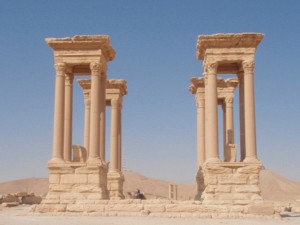
Bomb attacks in Syria’s capital, Damascus, and clashes between the government and rebel fighters in the ancient commercial hub Aleppo saddened entrepreneur Nina Halley, who has nothing but fond memories of her visit before the civil war.
Although the media has been rife with stories about terrorist attacks in public places and bombed towns badly in need of medical supplies, Halley remembers the soul of Syria and the glory of its ancient past.
Images of stone arches, lanes teaming with black-veiled women and keffiyeh-clad men, old men moving pushcarts, cobblestone streets, the echoes of prayers at night, the hammam or Turkish bath and desert oasis coexist with such modernities as boutique hotels and trendy restaurant bars tucked away in maze-like streets.

In 2010, Halley’s friend, Leonore de Leon El Khoury, a Filipina based in Lebanon was celebrating her birthday. She invited Halley and some French friends to visit Lebanon and Syria.
“The moment we crossed the Lebanon border, we felt something was not right. But the experience turned out to be beautiful,” recalled Halley.
The Damascus-based Beroia Travel Agency not only planned an eye-opening tour, but also provided them with a security guard. Back then, Syria already had a reputation for being a harshly controlled society, replete with undercover agents and police. Halley was warned against talking politics because even waiters were said to be part-time mukhabarat or intelligence agents.
There was fear in the atmosphere, brought about by the authoritarian regime of the Ba’ath Party.
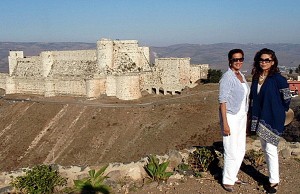
Still, Halley and her companions never felt unsafe, as the hotels offered sublime hospitality, and the food—grilled lamb, pomegranate juice, kibbeh nayeh (minced beef), and baba ganouj (eggplant with olive oil)—made them forget the troubles.
Walk in time
They spent the first few days in Aleppo, where they were billeted at the Al Mansouriya Palace, the 16th-century limestone quarters renovated by French designers who created the suites that echoed Syria’s royal past.
The group enjoyed Aleppo’s wonderful cuisine, the stone-vault souk, and the picturesque quarters, and visited sacred landmarks outside the city. The Archbishop of Aleppo Emile Assouad took the group to some neighborhoods and to his quarters.
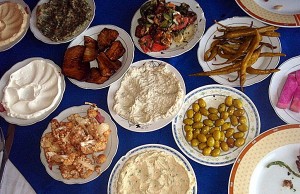
“If Moses walked through the markets of Aleppo, can you imagine how old the city is?” exclaimed Halley.
The medieval citadel offered awe-inspiring views from its notched defense walls. A Unesco World Heritage Site, the Citadel of Aleppo showcased the influence of medieval Arab architecture and how it was designed to protect itself against the Christians.
Yet, there were also the influences of early Greco-Roman street planning, Christian edifices, mosques and Islamic schools, limestone houses and exquisite courtyards, and the Great Mosque, which embodied fine Islamic architecture.
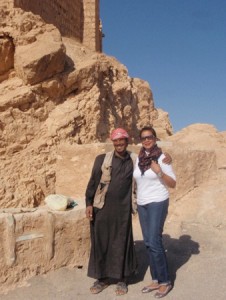
Syria was dotted with caravanserais or trade centers, where sellers and animals carried goods from other continents. They were built in the 18th century, when the Silk Road flourished and Syria became one of the biggest areas for commerce.
However, Aleppo was famous for the souk, a rambling complex of noisy corridors and stalls crammed with spices, silk, dried fruit, nuts, fabrics, pets, carpets, clothes, camel meat and jewelry.
Halley found the souks charming, with their Ottoman architecture and stone vaults. She shopped for Aleppo silk as a giveaway for her school reunion.
Halley and her group dressed up for an evening at Club d’Alep, the exclusive club patronized by chi-chi Syrians. When they arrived, the locals stopped their gossiping and dining and gawked at the foreigners. Halley’s group headed to their table and ordered the specialties—mezze or starters, a salad of green olives dressed with pomegranate molasses, puréed dips with walnuts and hot peppers, and main courses of soujouk (peppery sausage) and kibbeh (minced lamb). “The best was the kamayeh, a dish from Syrian truffles,” recalled Halley.

That evening, a writer from the Financial Times had also brought a group to enjoy Syria’s gastronomy.
Then there were the tours outside the ancient city. A Unesco World Heritage site, Krak des Chavaliers, an 11th century Medieval castle built on the hilltop outside of Homs Gap, a passageway in south Syria, was the first stop.
The Kurds, an ethnic group from Iran, originally occupied the place. It was also used as garrison during the Crusades.
A stone curtain wall protected the castle and its square and round towers. Halley’s group explored the courtyard encircled by vaulted chambers. They took photographs of the architectural elements that defended the castles, the cavernous chapel, the frescoes of the Crusaders and the arid panorama from the slopes of Tartus Hill.
Another hillside landmark outside of Aleppo was the ruins of St. Simeon Cathedral, the oldest Byzantine church, built in the fifth century. Aside from the pillar of the hermit monk St. Simeon Stylite, which was viewed on a boulder at the courtyard, the pilgrims walked the sacred grounds and explored the monastery, the four basilicas, the baptistery and the annexes.
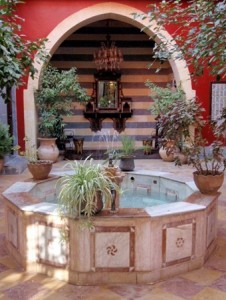
There was the obligatory visit to the Dead Cities. A sacred destination, Serjilla was like a ghost town with undone stone buildings. The center was a bathhouse stripped of its mosaic and more ruins.
In Hama, the main attraction was the series of nouras, old machines that transported water into a small aqueduct to irrigate the gardens. The travelers saw famous mosques and their mosaic art.
Desert oasis
Exploring Syria’s most famous ruined city, Palmyra, the tourist van traveled across the parched barrenness, past camels and tents of Bedouin nomads. It felt as if time had stalled when the visitors were taken to the majestic ruins, with the sight of Corinthian columns, battered archways, elaborate hillside crypts and temples unfolding across the terrain.
Inside a precinct lined by a colonnade, the Temple of Bel was built with two sanctuaries dedicated to the deities.

The group stayed at the Tadamora Palace Hotel and Spa, whose architecture mimicked the Hellenistic style of the nearby Temple of Bel.
In Damascus, Halley’s group explored the Old City with its medieval citadel of Islamic schools and Ottoman palaces. They crossed the Roman archway to the inner sanctum of the eighth-century Umayyad Mosque—the core of Damascus’ Old City. The mosque was a breadth of stone atop a former Byzantine church, which held the tomb of John the Baptist.
Next to the mosque was a courtyard house which offered views of the city and local cuisine. Close by was a coffee place where one could enjoy Turkish coffee and smoke narghile or water pipes.
For art exposure, the group visited the Azem Palace, the 18th-century citadel of the Ottoman governor, which became the Museum of the Arts and Popular Traditions. The architecture in itself was a marvel, with its mix of various natural stones used as decoration and ceilings painted with natural scenery.
Halley’s group stayed at the Talisman Hotel, an old Jewish palace transformed into an exquisite boutique hotel with intricate Damascene touches.
The group enjoyed Syrian cuisine, with the food always fresh and rich with aromatic spices. There were the al ouzi, baked wraps filled with rice with minced meat, green peas and nuts, and the Damacene falafel and cold meats.
Aleppo beckoned with its pastries made of pistachios, walnuts and pine nuts rolled in filo dough, or enveloped in threads of sugar floss.
At the end of their trip, what remained most significant to Halley was Syria’s great manuscript of destiny, layered with stories of religion and empires.
“We were one of the last tourists. We came two months before the Arab uprising. The tour was carefully arranged,” said Halley.
Sadly, one of the richest countries of yore is now being savaged by war.









































